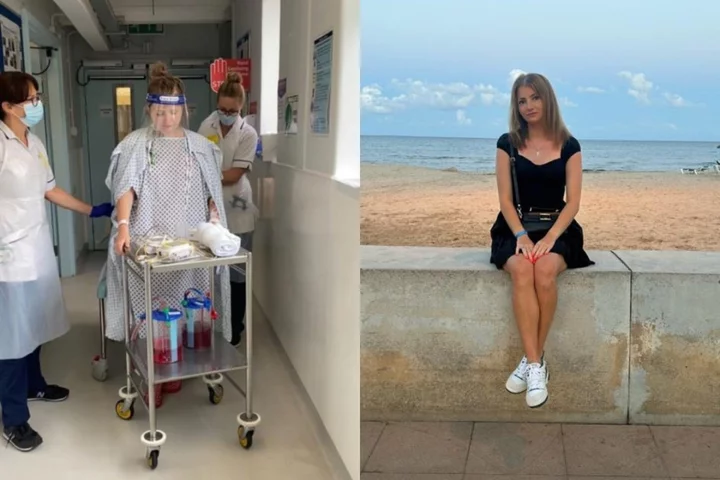
Woman with cystic fibrosis who had weeks to live before lungs transplant is now climbing mountains
A woman who felt she was being “suffocated” by her cystic fibrosis – and was told she had been just two weeks away from dying – has climbed Snowdon and run a half marathon after receiving two lungs from a transplant donor. Georgie Cooper, 26, was diagnosed with cystic fibrosis (CF) – a genetic condition which causes sticky mucus to build up in the lungs and digestive system – when she was two. The complaints and compliance officer, who lives in Essex, took medication and used nebulisers – machines which allow you to breathe in medicine – every day. She managed to maintain a “steady” lung function between 70 and 80 per cent until her health started deteriorating in her late teenage years. Cooper said 2018 was “the worst year” because she could not breathe properly and spent four months in and out of hospital as her lung function had dropped to 30 per cent and then to just 9 per cent. She was prescribed Orkambi, followed by Symkevi, to manage the condition. She was told she needed oxygen therapy 24 hours a day, which meant she had “tubes hanging out (her) nose”, and had to use a wheelchair. “It felt like constant suffocation, like I was being suffocated every minute, every second of every day.” Just two weeks before Christmas 2018, when she was 20, Cooper was told she had “a maximum of two years to live” and should consider a double lung transplant. While she waited for a donor, Cooper was prescribed Kaftrio to treat her CF, which she believes kept her alive. Her mother, Lesley, who she described as her “rock”, became her full-time carer and, after three false alarms, Cooper finally received the call that “we’ve got a set of lungs for you”. The surgery in June 2021, at Harefield Hospital in London, was successful – and came just in time. Cooper was told after the operation that her lungs had looked like “pulled pork” due to the CF damage, and she would have only lived for around two more weeks without the transplant. Before her surgery, Cooper had experienced three false alarms about suitable donors, and had started to believe that “to die would be peace”. During this time, she planned her funeral and created a “dream” bucket list – including going abroad again – to look forward to should she survive. She said she tried to stay positive as she knew she only had “a short time left on this Earth”, but found it extremely difficult knowing she was dying. “I had actually written my goodbye letters to my mum, dad, brother, my nan and pa, in case it didn’t work out, or in case I died before my transplant,” she said. She is incredibly grateful that the fourth call from the transplant service was a success. She describes her donor, who cannot be identified, as her “hero”. In August 2022, and after recovering, Cooper climbed Snowdon – now also known as Yr Wyddf and the highest mountain in Wales. She also completed the Bath Half Marathon in October 2023. “Snowdon, at that point, was my greatest achievement,” she said. “I felt like that’s the closest I’m going to get to my donor for now, which was really emotional. Someone else has selflessly given something of theirs to save another life – it’s incredible. She is the greatest hero that I never knew.” Cooper was born with no health complications, but soon developed a persistent cough, which raised alarm bells for her parents. After being referred to the Royal Brompton Hospital when she was two years old, she received her CF diagnosis and started taking medication and using nebulisers and having physiotherapy. While this was “normal” for Cooper, during secondary school she said she was “outed” as having CF during science lessons and her classmates and teachers discussed symptoms and life expectancy. According to the charity Cystic Fibrosis Trust, the median age of death of someone with CF in 2022 was 33. While Cooper was aware of the statistics, she said her peers at school would regularly say: “Oh you’re going to die soon, you haven’t got long left, have you?” Cooper says she cannot believe what she has overcome and achieved since the surgery, having also secured her first job as well as her running and mountain-climbing exploits. She now plans to climb Ben Nevis in Scotland – the highest mountain in the UK. While she still has to take immunosuppressants and struggles with survivor’s guilt, Georgie says she feels she has been “reborn” and now “lives for two people every day”. She was told her donor’s favourite quote was “your mountain is waiting”, which inspired her Snowdon adventure, and she wants to encourage others to “live every day like it’s your last”. She said: “Life is full of tablets, but I’m not having any physio, no nebulisers, and it’s like being reborn – it’s a life I’ve not known and I’m making up for lost time. I owe my life to my donor. She is my hero, she’s the greatest hero I never knew. It’s a gift of life, and that’s the best gift I’ll ever be given.” For more information and support, visit Cystic Fibrosis Trust’s website at: cysticfibrosis.org.uk. For more lung transplant information, visit: cysticfibrosis.org.uk/what-is-cystic-fibrosis/cystic-fibrosis-care/transplant-information-and-resources.
2023-11-15 19:57

Marlon Wayans reveals his child is transgender as he expresses ‘unconditional love’ for son
Marlon Wayans has revealed that his son is transgender. Now, the actor and producer is opening up about his own “transition” as the parent of a trans child. In an interview on The Breakfast Club on 10 November, the White Chicks star shared that his eldest child changed their name and pronouns. “I have a daughter that transitioned into a son,” the comedian said, adding that his child now goes by the name Kai. At first, Wayans admitted that his son’s transition was difficult for him to accept. However, he plans to focus on both Kai and the lessons he’s learned as a parent in an upcoming comedy special, tentatively titled Rainbow Child. “I talk about the transition, not their transition, but my transition as a parent going from ignorance and denial to complete unconditional love and acceptance,” Wayans said. “And I think there’s a lot of parents out there that need to have that message, and I know I’m dealing with it. It was a very painful situation for me.” The 51-year-old actor went on to praise Kai as “brilliant” but admitted that he’s “still working” on addressing his son by his correct pronouns. “They know I love them, they see me trying. They’re like: ‘I’m happy,’” Wayans said. “But I gotta respect their wishes.” He explained that his greatest wish for both of his children - including his 21-year-old son, Shawn - was to “be free” and confident in who they are. “I want them to be free in spirit, free in thought, free to be themselves,” Wayans said. “The more you know yourself, the more you can govern yourself. The more you live your truth, the happier your existence.” “I’m just so proud of them for being them,” he added. Wayans shares sons Kai and Shawn with his former partner, Angela Zackery. While the two were in a long-term relationship from 1992 to 2013, they were never married. The Air star has often shared glimpses into his life as a father of two on social media. Back in September 2022, Wayans celebrated National Son Day by posting throwback yearbook photos of both Kai and Shawn. “Happy #nationalsonday Shawn and Kai,” he captioned the amusing post. “I can’t believe y’all actually smiled like this for class pictures…The f***?! I told you it would come back to haunt y’all a**es.” In May, Wayans shared a birthday tribute for Kai by posting a sweet photo of him kissing Kai on the cheek after his graduation. In the caption, the comedian shared a special message to his transgender son, thanking him for “teaching me what [it] really means” to love unconditionally. “Happiest bday my baby… daddy loves you to the moon and back,” Wayans wrote. “I’ve always asked people to love me unconditionally, thank you for teaching me what that really means. Be you! Your best you! You’re the gift and I’m wrapping paper… love love love you for life. “Excuse my ignorance, chalk it up to growth. Love you so much, thank you for making me a man. So proud,” he added, alongside a rainbow emoji. Read More People crave comfort food more during the winter season - here’s why Gordon Ramsay’s daughters praise ‘rockstar’ mom after giving birth to sixth child Top 10 hacks to beat the afternoon slump People crave comfort food more during the winter season - here’s why Gordon Ramsay’s daughters praise ‘rockstar’ mom after giving birth to sixth child Top 10 hacks to beat the afternoon slump
2023-11-14 23:49
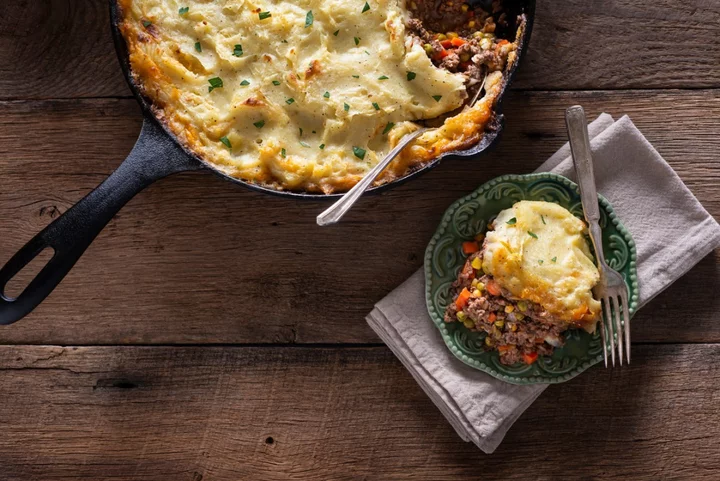
People crave comfort food more during the winter season
People will be spending 30 per cent longer in the kitchen this winter compared to the summer months – as they crave comfort foods to keep them warm. A study of 2,000 adults who cook at home found they anticipate spending 72 hours rustling up meals from December to February, but just 55 hours from June to August. And 40 per cent spend more time cooking in the cooler months than they do during any other season. Among the reasons for this upward trend are a craving for more hearty, comforting dishes (65 per cent), wanting to feel warm and cosy (42 per cent), and the kitchen being the warmest room in the house (32 per cent). It also emerged 51 per cent are concerned about the impact more time spent in the kitchen will have on their household bills. As a result, 79 per cent are keen to learn more energy-efficient recipes. The research was commissioned by Smart Energy GB, which has teamed up with Michelin-trained chef, Poppy O’Toole, dubbed TikTok’s ‘Potato Queen’, who has crafted a selection of energy-efficient recipes and hacks She said: “Winter is one of my favourite seasons when it comes to the wealth of hearty, comforting recipes you can create - especially if they include potatoes. “And when the weather is colder and the days shorter, what better way to spend time than cooking your favourite winter warmers? “These dishes can take more time and energy to make, which is why I’m excited to show it doesn’t always have to be this way. “I’ve developed a recipe range of energy efficient takes on classic favourites - all with the help of a smart meter.” The study also found 25 per cent of those with a smart meter plan to monitor their in-home display more carefully during the winter. Of those, 42 per cent are doing so because it gives them a greater sense of control over their household bills, while 40 per cent want to reduce their energy use when cooking. One in five of all adults are searching for more cost-saving cooking methods, and 77 per cent said being mindful about energy use when cooking is important to them. It also emerged the typical home cook will use their oven for the equivalent of nearly three days (64 hours) from December to February, and their hob for nearly two days (46 hours). This amounts to at least £18 in energy usage in the kitchen alone between December and February, according to data from Smart Energy GB and Energy Saving Trust. A traditional roast, shepherd’s pie and sausage and mash are among the most popular meals made when then temperature plummets. The study, conducted via OnePoll, also found 39 per cent are using more kitchen appliances in their cooking endeavours than ever before. The oven was voted the top winter appliance of choice (43 per cent), with the economical air fryer (27 per cent) also featuring in the top 10. Victoria Bacon, director at Smart Energy GB, said: “As we head into the colder, winter months where many people spend more time in the kitchen, small changes to the way we cook can make a tangible difference to the amount of energy that’s used. “Smart meters are installed at no extra cost by your energy supplier and come with a handy in-home display which allows you to track your usage in near-real time. “These warming recipes created by Poppy are the perfect thing to help households rustle up hearty dish, while keeping an eye on energy use.” Read More Watch live as gun salutes mark King Charles III’s 75th birthday Woman defends her $7,000 cheese board How to host a dinner party for under £2 per portion Man shows the increase in grocery prices since 2019 Starbucks customer reveals comical result of her request for half sandwich Waitrose Christmas advert features Graham Norton cameo at kid-free festive party
2023-11-14 20:23
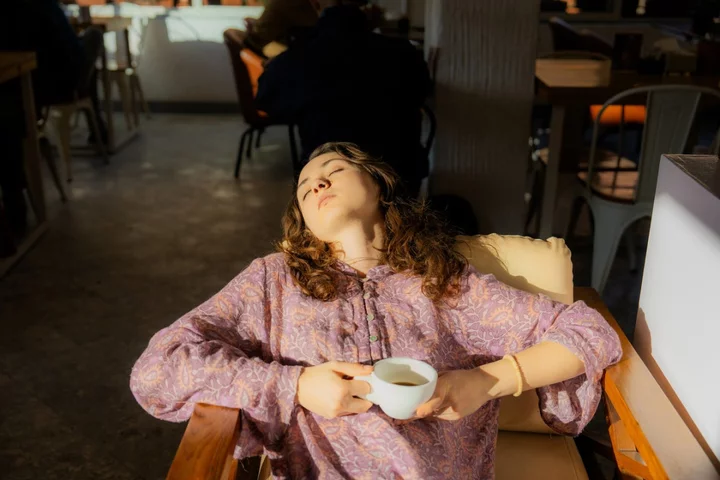
Top 10 hacks to beat the afternoon slump
An expert has revealed how to beat the afternoon slump, including chewing gum, having a ginger shot – and watching cute cat videos. Nutritionist and mental health advocate Rosie Millen, has revealed the top 10 hacks to get yourself out of the energy lull, which also includes grabbing a colouring in book, making a ‘slump’ playlist and spraying your favourite perfume. According to Rosie, watching heart-warming videos of cats can have a huge impact on your mood and energy levels, and also decreases stress. While studies show that simply chewing gum increases blood flow to the brain, which then makes you more alert. And drinking a shot of ginger – which is a natural energy booster – can also help you out of a slump. It comes after a study of 2,000 adults found they suffer an average of three energy slumps a day, with 2.36pm the most common time to hit the wall. But 49 per cent admitted they have no idea how to avoid the energy loss. ‘Lack of sleep was found to be the top cause of an energy slump’ Rosie, who is working with Vitabiotics Feroglobin in a bid to help people cope with the dreaded afternoon slump, said: “We’ve all been there. Some of us more than others. And when it hits, it hits hard. “We all know the obvious solutions on hand – exercise, have a cup coffee or take a nap. “But what are some of the more unconventional hacks at our fingertips that can also help bring you out of your energy lull and allow you to get on with your day.” Following the findings, a quiz has also been created to allow you to test how at risk of a slump you are, and whether you need to work to boost your energy levels. A lack of sleep was found to be the top cause of an energy slump for 45 per cent, followed by not drinking enough water (25 per cent), not exercising (22 per cent) and not having the right foods (21 per cent). But 19 per cent blamed it on having to complete a boring activity while 12 per cent suffer a slump when they are in a meeting that goes on for too long. Worryingly, 34 per cent have even had an energy slump while driving. As the result of the lull in their energy levels, 21 per cent have cried and 19 per cent have argued with their partner. Others admitted to cancelling a social engagement (19 per cent), forgetting they were meant to be somewhere (16 per cent) or shouting at their children (15 per cent). While 12 per cent have even fallen asleep in a meeting and 10 per cent have made a mistake at work. But in a bid to beat the slump, 37 per cent have turned to coffee while the same percentage has tried going for a walk outside. Three in 10 consume sugary snacks, 26 per cent splash their face with water and 12 per cent put some loud music on. It also emerged the average adult complains of feeling tired three times a day, with 39 per cent admitting their lack of energy is often a topic of conversation with friends. However, a quarter of those who suffer with energy slumps, polled via OnePoll, have been so concerned, they have visited a doctor or medical professional. To try and boost their energy levels and avoid a slump, 38 per cent have attempted to improve their sleeping pattern while 36 per cent have done more exercise. Others have changed their diet (30 per cent), taken supplements (30 per cent) or taken more breaks throughout the day (26 per cent). A spokesperson for Vitabiotics Feroglobin said: “We’ve all experienced an energy slump – and when it hits, it can be really hard to get out of it. “But as well as learning how to beat it, it’s important to learn how to avoid the slump in the first place. “Your diet and nutrition can have a huge impact on your energy levels, so making sure you are eating the right foods and getting the vitamins and minerals you need can go a long way to beating the slump.” Here are some top tips to beat the slump: 1) Watch cute cat videos Believe it or not, watching cat videos can have a profound effect on your mood and energy levels. A study from the Indiana University Media School of 7,000 people found that watching cat videos not only improves your mood but also decreases stress and re-energises you for when you return to your work. 2) Eat an iron rich snack You need iron to carry oxygen to the muscles and organs in the body. When iron levels are low, this can contribute to fatigue. So make sure you get some iron rich snacks every day to keep your levels up. Good recommendations include dried fruit and pumpkin seeds, dark chocolate and houmous with chopped veg. 3) Chew gum This semi-strange tip actually has science to back it up. A study from the journal of physiology and behaviour found that chewing gum increases blood flow to the brain which in turn improves alertness. 4) Grab a colouring in book Not only does colouring in alleviate stress and reduce anxiety it is like a full brain workout for your neurologic system. While colouring, you use the parts of your brain (the frontal lobe) that enhances focus and concentration. Certain colours, such as yellow and orange, are also thought to increase energy. 5) Jump into an ice bath or have a very cold shower Experts say that cold showers boost the immune system and increase energy levels. Scientists believe it improves circulation and blood flow to and from the muscles. It is also thought to improve your mood. A 2008 study found that the use of cold showers on a daily basis decreases depressive symptoms. 6) Make a playlist Music has an incredible impact on our mood and can absolutely transform your energy levels even in a short space of time. Just popping in your earphones and blasting your favourite song alters brainwaves and improves cognitive performance. New research from the British Academy of Sound Therapy found that after listening to music for just nine minutes, 65 per cent of test subjects reported they were happier and laughed more, 89 per cent had improved energy levels and 82 per cent felt more in control of their lives. So, get a playlist ready before you start to crash. 7) Turn up the lights If you’re feeling slumped turn up the lights in your house. The high colour temperature of bright and cool lights triggers the release of serotonin, which makes us more alert and energetic. Results of a study with 52 test subjects showed that people felt more alert and energized after having been exposed to bright light. Stepping out into the sunshine is also a gamechanger. The effects of vitamin D and energy are well documented. Fatigue is one of the main symptoms of vitamin D deficiency. 8) Spray your favourite perfume A lot of clinical research supports claims that certain essential oils increase energy and relieve fatigue. Peppermint oil, for example, is effective for preventing fatigue and improving exercise performance. And eucalyptus is thought to awaken the mind and increase mental clarity. You can either inhale essential oils directly, spray a perfume with them in, add a few drops to your shampoo or opt for an energising massage (time and finances permitting). 9) Call a friend Unsurprisingly, socialising with friends can be really lifting. Dopamine and oxytocin are released when you socialize which in turn boosts your mood, reduces cortisol levels and lowers stress. In fact, social isolation has more far-reaching negative effects. New research suggests that being alone for too long is comparable to smoking up to 15 cigarettes a day. 10) Have a ginger shot Ginger is a natural energy booster and may be able to give you the kick you are looking for mid-afternoon. Studies suggest it has stimulatory effects. Just make sure you go for as fresh as possible without any added sugar. Read More What are the symptoms of Parkinson's disease and how can it be treated? What is silent reflux? Yoga may reduce seizure frequency in epilepsy patients, scientists say Yoga may reduce seizure frequency in epilepsy patients, scientists say Jonnie Irwin says he ‘never thought’ he’d be alive to see his 50th birthday Billy Connolly shares health update on Parkinson’s disease: ‘Every day gets stranger’
2023-11-14 00:18
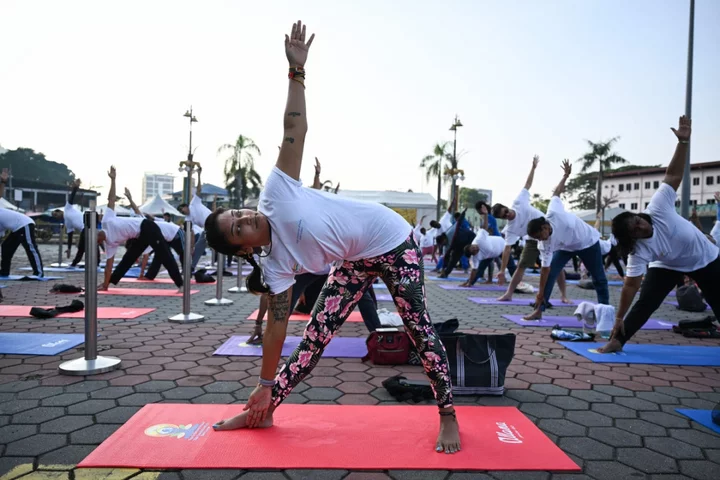
Yoga may reduce seizure frequency in epilepsy patients, scientists claim
Doing yoga may help reduce frequency of seizures in people with epilepsy and lower their anxiety, a new study found. The practice may also improve patients’ overall quality of life by reducing the stigma they feel from having the disease, according to the research, published last week in the medical journal Neurology. “People with epilepsy often face stigma that can cause them to feel different than others due to their own health condition and that can have a significant impact on their quality of life,” study author Manjari Tripathi from All India Institute of Medical Sciences (AIIMS) in New Delhi said. “This stigma can affect a person’s life in many ways including treatment, emergency department visits and poor mental health,” Dr Tripathi explained. In the study, researchers assessed people with epilepsy with an average age of 30 in India. They measured stigma among participants based on their answers to questions such as: “Do you feel other people discriminate against you?” “Do you feel you cannot contribute anything in society?” and “Do you feel different from other people?” About 160 people who met the criteria for experiencing stigma were then identified. These patients had an average of one seizure per week and on average took at least two anti-seizure medications, researchers said. One set of patients were then randomly assigned to receive yoga therapy, which included exercises in loosening muscles, breathing, meditation and positive affirmations. Another set of patients received a sham therapy that mimicked the same exercises, but these participants were not given instructions on two key components of yoga – slow and synchronized breathing, and attention to the body movements and sensations. Both the groups received seven supervised group sessions of 45 to 60 minutes over three months. They were also asked to practice sessions at home at least five times a week for 30 minutes and track their seizures and yoga sessions in a journal. Participants were then followed for an additional three months after their first three months of therapy. People who did yoga were more than four times as likely to have their seizure frequency more than halved after six months than the people who did sham yoga, the study found. Compared to those who did the sham practice, participants who did yoga were more likely to reduce their perceived stigma of the disease, researchers say. People who did yoga were also over seven times more likely to no longer have seizures than those who did the sham practice, according to the study. Researchers also reported a significant decrease in anxiety symptoms among those who did yoga versus people who did not. “The intervention group showed significant improvement in symptoms of anxiety, cognitive impairment, mindfulness and quality of life relative to the control group at the end of follow-up period,” researchers wrote. “Yoga may not only help reduce stigma, but also improve quality of life and mindfulness. Plus, yoga can be easily prerecorded and shared with patients online using minimal resources and costs,” Dr Tripathi said. Citing the main limitation of the study, researchers said the participants self-reported their seizure frequency and they may not have remembered all the information accurately. However, they say the findings “elevate the need to consider alternative therapies and activities for people with epilepsy facing stigma”. Read More Jonnie Irwin says he ‘never thought’ he’d be alive to see his 50th birthday Billy Connolly shares health update on Parkinson’s disease: ‘Every day gets stranger’ What are the symptoms of Parkinson's disease and how can it be treated? Jonnie Irwin says he ‘never thought’ he’d be alive to see his 50th birthday Billy Connolly shares health update on Parkinson’s disease: ‘Every day gets stranger’ What are the symptoms of Parkinson's disease and how can it be treated?
2023-11-13 12:53

Jonnie Irwin says he ‘never thought’ he’d be alive to see his 50th birthday amid terminal cancer diagnosis
TV star Jonnie Irwin has admitted that he “never thought” he’d be alive to see his 50th birthday, which is next week. Irwin, 49, who is best known for presenting property TV shows A Place in the Sun and Escape to the Country, was diagnosed with terminal cancer in 2022. In January, Irwin threw an early 50th birthday party, ahead of the actual date next week, with a huge part with 170 friends and family. But in a new interview, the presenter has said he will be jetting off on holiday to Spain with his family for his actual birthday. “I never thought I’d be here,” Irwin told The Sun. “I’m really looking forward to some time with [wife] Jess and the boys.” Irwin shares three young sons with his wife, Jessica Holmes. He has been praised for his transparency about his condition, and his experiences with various cancer treatments. Since his diagnosis, Irwin has followed a strict diet and spends one to two hours a day in an O2Worx hyperbaric oxygen tent. Some studies have shown that flooding the body with oxygen does not promote tumour growth and has been linked to preventing cancer growth. In July this year, Irwin discussed his “really good” experience with palliative care, which focuses on improving the quality of life for anyone facing a life-threatening condition. Irwin said that he has been in palliative care since the day he received his terminal cancer diagnosis. He was first diagnosed with lung cancer in August 2020, but only publicly shared the news in November 2022 after the cancer spread to his brain. His hospice experience was a “delight”, Irwin said, challenging his initial perception that such facilities were “very much a boiling hot room full of people who looked frail and towards the end of their days”. In September, the presenter made his long-awaited return to TV when he hosted a new episode of Escape to the Country on BBC One. Looking back at his time in a hospice six months ago, Irwin said he was “on the cusp of death”. “Lying in the hospice, I thought I’d had it,” he told The Sun. ​​“But at my weakest point I thought, ‘This is it, this is the beginning of the end.’” ​​Irwin returned home and resumed his strict diet, drinking protein shakes and spending time in the oxygen tent to attempt to curb the growth of his cancer. “I won’t let cancer define me,” Irwin told the publication from his newly renovated home in Newcastle. “A friend of mine told me, ‘Your body achieves what your mind achieves’, and I want to live by that.” Read More Jonnie Irwin jokes he’s ‘whacked’ after attending The Streets gig in Newcastle Billy Connolly shares health update on Parkinson’s disease: ‘Every day gets stranger’ What are the symptoms of Parkinson's disease and how can it be treated? Billy Connolly shares health update on Parkinson’s disease: ‘Every day gets stranger’ What are the symptoms of Parkinson's disease and how can it be treated? Tracey Emin says she ‘totally accepted death’ following cancer diagnosis
2023-11-13 00:20

Billy Connolly shares health update on Parkinson’s disease: ‘Every day it gets stranger and more different’
Billy Connolly has said that every day spent living with Parkinson’s disease “gets stranger”, as he shared an update on his health. The Scottish actor, 80, has been living with the condition since 2013, and said that the symptoms and lifestyle impacts of the disease often “creep up” on him. Parkinson’s is a brain disorder that causes unintended or uncontrollable movements, such as shaking, stiffness, and difficulty with balance and co-ordination. Often, the disease can become more severe over time. “Every day it gets stranger and more different,” the retired stand-up comedian told The Times. Connolly said that his newfound love for making drawings, painting and sculptures has helped him navigate the mental health toll of living with the condition. “I don’t know how I would have coped without drawing. It’s taken me out of the scene and put me somewhere else, where I can survey it from a different angle,” he said. “Art has made my life magical at a time when I thought it would be unbearable.” It’s been a decade since Connolly received his Parkinson’s diagnosis. The comedian was walking through the lobby of a Los Angeles hotel in 2013 when a fellow guest, a doctor, stopped him and said he shows physical signs of Parkinsons. This prompted Connolly to visit his doctor. “I’ll never forget what he said: ‘You have the gait of a Parkinson’s man,’” Connolly told the publication. According to Parkinson’s UK, Bradykinesia, which is a common condition among people with Parkinson’s, means slowness and a reduced range of movement when walking. It can make your steps smaller and it can take more time and effort to get around. When Connolly received his official diagnosis, he was also diagnosed with prostate cancer and gallstones in the same week. “It was a helluva week,” he said. “It got funny. My daughter Scarlett was with me in the ambulance on the way to the gallbladder surgery through Manhattan. The sirens were going – nee-naw nee-naw – and she said to me, ‘Is this your first Caribbean cruise?’ That’s a line I always said to her to make her laugh when her surroundings were awkward or boring.” During an interview published in September, it was revealed that Connolly had suffered “a couple of serious falls” and once broke his hip as a result of deteriorating balance. He no longer drives. Despite these growing physical challenges, the What We Did on Our Holiday star maintains a positive outlook on his health. In his memoir, Rambling Man: Life on the Road, which was released earlier this year, Connolly clarified that he doesn’t feel “close to death”. “You see, reports of my recent demise have been greatly exaggerated,” he stated in an extract shared with The Telegraph. “There was a week a few years ago where on Monday I got hearing aids, Tuesday I got pills for heartburn, and Wednesday I received news that I had prostate cancer and Parkinson’s disease. But despite all that, I never ever felt close to dying.” Rambling Man: Life on the Road is available now. Read More What are the symptoms of Parkinson's disease and how can it be treated? Tracey Emin says she ‘totally accepted death’ following cancer diagnosis Nicky Hilton calls out critics who made negative comments about nephew Phoenix’s head What are the symptoms of Parkinson's disease and how can it be treated? Tracey Emin says she ‘totally accepted death’ following cancer diagnosis Nicky Hilton calls out critics who made negative comments about nephew Phoenix’s head
2023-11-11 21:22

What are the symptoms of Parkinson’s disease and how can it be treated?
Parkinson’s disease is the world’s second most common neurodegenerative disorder, behind Alzheimer’s disease. While it’s unknown exactly why people develop the condition, according to Parkinson’s UK, experts believe its a combination of genetic and environmental factors that contribute to the damage of nerve cells in the brain. So what are the symptoms of Parkinson’s disease and how can it be treated? Here’s everything you need to know. What is Parkinson’s disease? Parkinson’s disease is a degenerative neurological condition. This means that over time the brain of an individual living with the disease becomes more damaged, the NHS explains. A person living with Parkinson’s disease doesn’t have enough of the chemical dopamine in their brain, the Parkinson’s Foundation states. Dopamine is responsible for transmitting signals between nerve cells in the brain. When an individual experiences a loss of nerve cells in the brain, this causes a reduction in the quantity of dopamine in the brain. What are the symptoms? The main symptoms of Parkinson’s disease include involuntary shaking (otherwise known as tremors), movement that’s slower than usual and stiffness in the muscles, the NHS outlines. Other symptoms may include difficulty balancing, nerve pain, incontinence, insomnia, excessive sweating, depression and anxiety. For more information about the symptoms of Parkinson’s disease, visit the NHS here. How many people does it affect? Around 145,000 people in the UK are affected by Parkinson’s disease, Parkinson’s UK explains. This means that around one in every 350 adults is living with the degenerative condition. According to the NHS, symptoms of Parkinson’s usually develop after the age of 50. However, for every one in 20 people affected by the disease, symptoms may appear when they’re under the age of 40. The Parkinson’s Foundation outlines that men are 1.5 more likely than women to be affected by the condition. High-profile individuals to have been diagnosed with Parkinson’s include former US president George H. W. Bush, Back to the Future star Michael J. Fox and The Chase star Paul Sinha. How can it be treated? While there is no known cure for Parkinson’s disease, symptoms may be controlled through treatment. The most common form of treatment used for the condition is medication, Parkinson’s UK states. “Drug treatments aim to increase the level of dopamine that reaches the brain and stimulate the parts of the brain where dopamine works,” the charity explains. The medication used to treat Parkinson’s disease varies according to each patient. This is because as symptoms of the disorder progress, the drugs used to treat the condition may need to be changed. While drug treatment may help to manage Parkinson’s symptoms, it cannot slow the progression of the disease. The NHS explains that those living with Parkinson’s disease may also undergo physiotherapy, occupational therapy, and, in rare cases, brain surgery to treat the condition. For more information about Parkinson’s disease, visit Parkinson’s UK. Read More What are symptoms of coronavirus – and where has it spread? Latest travel updates as coronavirus continues to spread Can face masks really protect you against coronavirus or flu? The dirty truth about washing your hands Billy Connolly shares health update on Parkinson’s disease: ‘Every day gets stranger’ Tracey Emin says she ‘totally accepted death’ following cancer diagnosis Nicky Hilton calls out critics who made negative comments about nephew Phoenix’s head
2023-11-11 21:18

Scientists say monthly visits from family and friends can help you live longer
Scientists have found that visiting friends and family at least once a month can help you live longer. According to a recent study published by the University of Glasgow in BioMed Central Medicine, researchers discovered that there was a correlation between how often a person was visited by their family and friends with their life expectancy. Those who were never visited by their family reportedly had a higher risk of dying. Amid the ongoing loneliness epidemic, social isolation has previously been linked by researchers to a shorter life expectancy. This latest study sought to understand the effect that different types of social interaction have on our quality of life, with visits from friends and family, participating in a weekly group activity, and not living alone reportedly making the biggest difference among a group of 458,146 participants in the United Kingdom. Participants were between the ages of 37 and 73, with the average age being 56 years old, and data was collected between 2006 and 2010. Researchers asked the participants questions about the five different forms of social interaction: how often they were able to confide in someone close to them, how often they felt lonely, how often friends and family visited, how often they participated in a weekly group activity, and whether or not they lived alone. “We also tried to take into account lots of other factors that could explain the findings — like how old people were, their gender, their socioeconomic status, whether they were a smoker and more,” Dr Hamish Foster, a clinical research fellow at the University of Glasgow and the lead study author, explained to Insider. “And even after removing those factors from the equation it still showed that these social connections were important for risk of death.” Depending on when the participants were recruited, researchers would revisit the questions with the participants an estimated 12.6 years later to follow up. They reportedly found that, within those years, 33,135 or 7.2 per cent of participants died, with 5112 or 1.1 per cent passing from cardiovascular-related deaths. Strikingly, the study also found that “regardless of weekly group activity or functional components,” those who never had friends or family visit while also living alone were 77 per cent more likely to have a higher risk of death. However, Dr Foster cautions that the study is unable to take into account both the complexity and the quality of human social interactions. “Humans are really complicated and so are our connections and our measures in this study are pretty crude compared with what humans are capable of, but this study is still very detailed and is starting to drill down into how different types of connection are important,” Foster said to the outlet. He added that the study cannot prove that less socialisation causes death, but it does prove that loneliness and isolation can lead to not only poorer mental health but also poorer physical health. “We need to see more society-level interventions and support that make social connections easier, more likely, and of higher quality,” Foster added. “For example, community centers, parks, places, and activities that make it easy for people to meet and connect for high-quality relationships.” Dr Foster and his team of researchers aren’t the first to connect the dots between longer life spans and active social lives, with Netflix recently shining the spotlight on the famed blue zones - places with notably high populations of centenarians - in the docuseries, Live to 100: Secrets of the Blue. Within blue zones like Ikaria, Greece, or Okinawa, Japan, social interaction is prioritised within the community rather than being left on the backburner in favour of economic or individualistic pursuits. As the digital age and the pandemic have brought on an increase in social isolation, Dr Foster stressed that it’s important for young people to nurture their social lives and participate in their communities. Read More Blake Shelton opens up about parenting style with Gwen Stefani To shave or not to shave: How women can participate in No-Shave November Game of Thrones actor announces ‘unbearable loss’ of baby after stillbirth
2023-11-11 05:56

Blake Shelton opens up about parenting style with Gwen Stefani
Blake Shelton has speaken about his experience of being a stepfather. The country music singer appeared on the Today show to promote his new restaurant opening soon in Las Vegas. The interview also featured The Voice alum’s take on parenting since being a stepdad to his wife Gwen Stefani’s three sons. “I’ve had stepparents,” Shelton said. “I think it’s, in some ways, harder more difficult. I try to be careful about when to step back ... and just talk, but no matter what, always be there if I’m needed.” Stefani shares her three children, 17-year-old Kingston, 15-year-old Zuma, and nine-year-old Apollo, with her ex-husband Gavin Rossdale. Soon after divorcing Rossdale, the “Just a Girl” singer met Shelton while being coaches on The Voice together. The two tied the knot in 2021. “I didn’t see any of this coming with Blake. This was just a big old ‘What?’ It was an amazing gift to experience love like that for the first time,” Stefani confessed in an interview with People. “He’s changed my life ... when I [started dating] Blake, that’s when I felt home, like: ‘Oh, this is where I’m supposed to be, with this guy.’” Their home base is now in the “Sooner State” amid open land. For Stefani, who grew up in Southern California, she has been surprised to find she is now a “garden flower nerd”. “When I was young, I’d walk home from school and see my mom in her shorts doing her gardening, and my dad would be cutting the trees and make me pick up the branches,” Stefani said. “I’d be like: ‘I’m never having a tree at my house.’” “When we get to Oklahoma, we’re constantly working — and it’s a different kind of work,” she continued. “It’s probably what my mom was doing back in the day, and now I get it!” In conversation with People, she opened up about prioritising her children, and spoke about a special time in her life when she brought her eldest on tour with her. “I took Kingston on a world tour [when he was nine months old]. I would have to nurse him, then get onstage, come off, and he would twirl my ponytail,” Stefani remarked. “That’s when things got really hard for me emotionally. That time is so precious, and you don’t want to miss anything.” Though she’s continuing her journey as a mentor on The Voice, Stefani’s trying her best to manage a balance between work and home. “When my kids were teenagers, I really wanted to make sure that I was home for them,” she noted. “And here we are.” While Shelton has since become a stepfather to Stefani’s three sons, her ex-husband recently revealed on the Not So Hollywood podcast that he doesn’t “really co-parent” with Stefani and her new husband. The rocker cited their “opposing views” stemming from the fact that both parties are “really different people.” “I think you can go one of two ways,” Rossdale explained on the podcast in June. “You can either do everything together... or you can just parent. And I think we just parent.” Read More To shave or not to shave: How women can participate in No-Shave November Game of Thrones actor announces ‘unbearable loss’ of baby after stillbirth Nicki Minaj opens up about navigating parental anxiety after birth of her son To shave or not to shave: How women can participate in No-Shave November Game of Thrones actor announces ‘unbearable loss’ of baby after stillbirth Nicki Minaj opens up about navigating parental anxiety after birth of her son
2023-11-11 05:21

Game of Thrones star Thor Bjornsson announces ‘unbearable loss’ of baby after stillbirth
Game of Thrones star Hafþór Júlíus Björnsson has announced that he and his wife, Kelsey Henson, experienced the “unbearable loss” of a stillbirth. In a joint Instagram post shared on 10 November, the actor - known for his role as “The Mountain” in the HBO drama series - revealed that his daughter Grace Morgan Hafthorsdottir was delivered at 21 and a half weeks. “It is with great sorrow that we announce the birth of our daughter, Grace Morgan Hafthorsdottir born Nov 8th at 21 1/2 weeks gestation,” the couple captioned the post. “After a noticeable decrease in movement we found out her heart had stopped beating,” Björnsson and Henson continued. “Words cannot describe our pain of this loss or our happiness at being able to spend time with our daughter. She is absolutely beautiful, with blonde lashes and brows and a little smile for mom and dad.” “The love we feel for her is overwhelming. The grief we feel will be with us forever but so will the love. All of our hopes and dreams for her have been taken away from us but I know I will be with her again,” they added. “Her spirit lives on through us and her siblings. We ask that you respect our privacy at this time as we grieve this unbearable loss. Thank you all for any kind words and support.” Björnsson and Henson shared several photographs from the hospital, including images of baby Grace. The 34-year-old professional strongman could be seen lying with his wife in the hospital bed, as they looked down at their daughter wrapped in a white cloth. Another image showed the couple’s three-year-old son, Stormur, sitting alongside his mother and holding baby Grace. Many friends and followers took to the Instagram comments to share their condolences for the couple. “So sorry for your loss,” wrote actor Terry Crews in the comments. “My heart goes out to you both and Stormur,” said fellow athlete Martins Licis. “I’m sorry for your loss, and can’t even begin to imagine what you’re going through. May you guys find peace at whatever pace needed by your hearts.” “Thor, I am so sorry. We all love you big man,” added filmmaker Christopher Bell. In October, the pair announced they were expecting another baby with a sweet Instagram post. Their son could be seen standing in front of his parents, wearing a black T-shirt that read "brother” and holding pictures of Grace’s ultrasound. “Life is precious and I couldn’t be happier to announce that our family is growing bigger,” Björnsson captioned the post. “Kelsey is 19 weeks pregnant with a healthy child who we cannot wait to meet!” Björnsson and Henson tied the knot in October 2018 in the actor’s home country of Iceland. In addition to son Stormur, Björnsson also shares daughter Theresa Líf with ex-girlfriend Thelma Björk Steimann. Read More Nicki Minaj opens up about navigating parental anxiety after birth of her son How much water should we be drinking in a day? Irina Shayk reveals how she and Bradley Cooper make co-parenting daughter Lea ‘work’ Nicki Minaj opens up about navigating parental anxiety after birth of her son How much water should we be drinking in a day? Irina Shayk reveals how she and Bradley Cooper make co-parenting daughter Lea ‘work’
2023-11-11 02:47

Nicki Minaj opens up about navigating parental anxiety after birth of her son
Nicki Minaj has opened up about her feelings of anxiety after becoming a new mother. The rapper, 40, is the latest Vogue cover star for the magazine’s December 2023 issue. Speaking to the publication, Minaj shared many details about her ongoing motherhood journey, after she and husband Kenneth Petty welcomed their son in 2020. Minaj and Petty, who were married in 2019, were formerly high school sweethearts and grew up together in the same neighbourhood in Queens, New York. The “Superbass” singer explained how Petty was unfazed by her level of fame, and noted that he even calls her by her real name - Onika Tanya Maraj. “Because I’ve known my husband for so long, there’s an ease we have with each other,” she told Vogue. “We make each other laugh. We’re silly. And we’re always reminiscing about some old story. If it was a guy that I met as Nicki Minaj, I think I’d feel like they liked me because I’m Nicki Minaj, and what if I don’t look like Nicki Minaj every day? And that, combined with pregnancy, would probably have made me crazy.” The pair welcomed their son, who Minaj has nicknamed “Papa Bear” on social media in order to keep his privacy, on 30 September 2020. The “Barbie World” rapper admitted that she and Petty struggled with their relationship after becoming a family of three, much like many couples do when they become new parents. “I’m not going to lie, things got testy between us. Because of our history, I think we knew we’d get past it. But there’s no such thing as confidence in parenthood,” she explained, before recalling the amount of anxiety she felt after becoming a mother. “I kind of wish that someone had told me - although I’m sure I wouldn’t have been able to understand it - that there’s a level of anxiety, and you think it’s going to go away, but in fact it gets scarier,” Minaj added. “So often you think: I don’t know how to do this!” Minaj’s highly-anticipated fifth studio album, Pink Friday 2, is due for release on 8 December. The “Starships” singer previously told her millions of fans on X, formerly known as Twitter, that she had “decided to retire and have my family” just one month before she and Petty were married. However, the Grammy nominee soon realised that the studio was still calling her name - even if that meant needing to balance her family life with her professional career. “I think that deep down inside, I believed that once I had a family, I would just lose the desire to make music,” Minaj told Vogue. “I would always tell people: ‘Watch, when I have a child I’m going to cook every meal for him and bake cookies every day.’ Maybe subconsciously I hoped my focus would just be on being a mother, and I looked forward to that idea. It felt like a relief. But what happens is that you find out you have to work.” This isn’t the first time Minaj has opened up about feeling anxiety as a new mother. In an interview with E! News published in October 2022, the rapper revealed that she often feels like her “heart is being ripped out” when she is away from her now-three-year-old son. “I hate that I have more anxiety now because you’re like: ‘What if the one time I leave my child, I get that phone call?’” she said at the time. “I think moms feel like they have to be perfect.” Minaj then recalled when she was in the United Kingdom and started “bawling” over being away from her son. “And when I try to FaceTime him, I get more sad,” she said. “So, I try to hold out on FaceTiming him because to then put the phone down is so difficult.” The “Super Freaky Girl” rapper shared that she and Petty have never hired a nanny to take care of their baby. “I’m a Trinidadian woman,” she said. “Culturally, we’re not really used to nannies and strangers taking care of the babies. “It’s not a bad thing when moms do it. It’s just that I have to get conditioned. I have to get it out of my mind that it’s a weird thing, because there are tons of celebrities that are doing it and they’re raising amazing children.” Back in September 2020, Minaj announced the birth of her son by posting several photographs of handwritten notes from her celebrity friends congratulating her on the baby news. One of the pictures in the post featured a note from Beyoncé, which read: “Onika, welcome to motherhood. God bless you and your family. B.” “Thank you to Queen B, Kim & Ye, Riccardo Tisci, Winnie, Karol and everyone who sent well wishes during this time. It meant the world to me,” Minaj captioned her post. “I am so grateful and in love with my son. Madly in love. My favorite liddo boy in the whole wide world.” Read More How much water should we be drinking in a day? Irina Shayk reveals how she and Bradley Cooper make co-parenting daughter Lea ‘work’ What is silent reflux? How much water should we be drinking in a day? Irina Shayk reveals how she and Bradley Cooper make co-parenting daughter Lea ‘work’ What is silent reflux?
2023-11-10 06:29
You Might Like...

Skin cancer cases reach record high – how to spot the signs

Chrissy Teigen and John Legend welcome fourth child via surrogate: ‘Our new love’
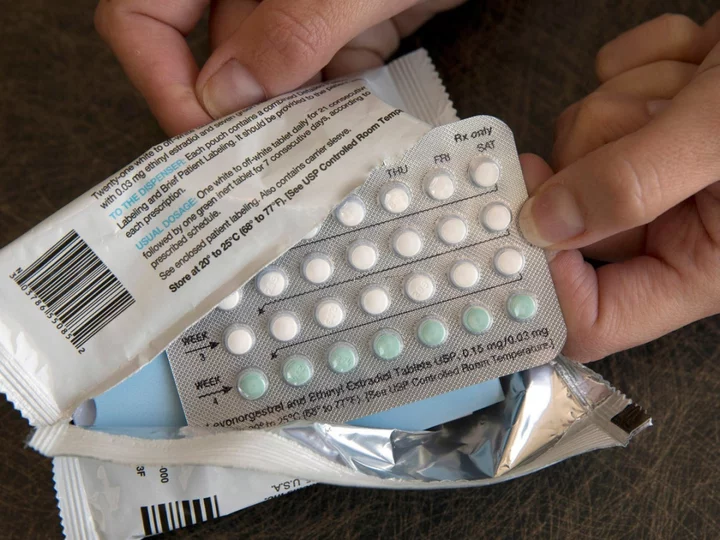
Millions of women able to get contraceptive pills over the counter next year

Frank Alfred Odysseus: The meaning behind the name of Carrie and Boris Johnson’s third child
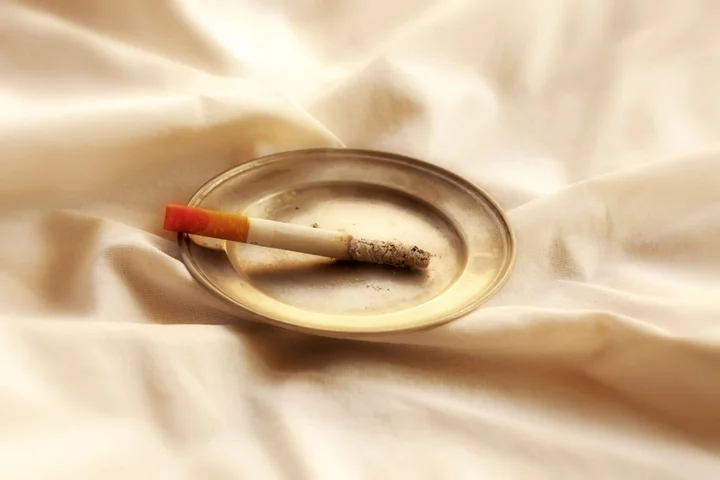
Smokers 2.6 times more likely to give birth prematurely
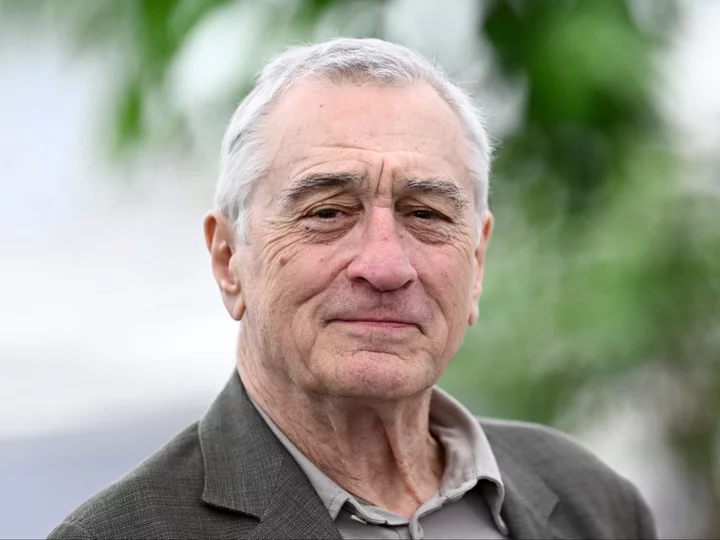
Robert De Niro’s family: What to know about his seven children and their mothers

Dermatologist freaks viewers out after ‘catching’ mites that live in pores

Mother sparks debate after she criticised parent who wouldn’t give her daughter a slice of birthday cake
